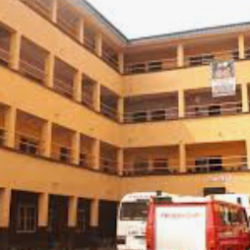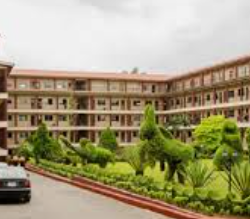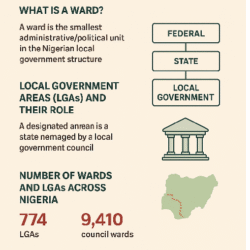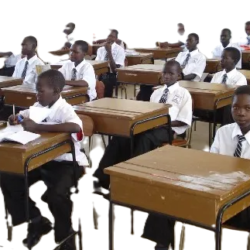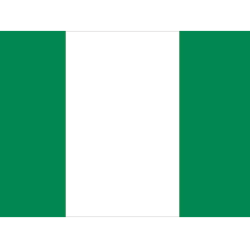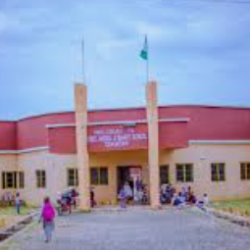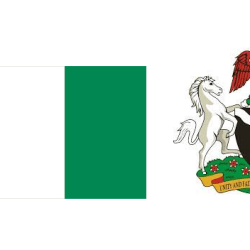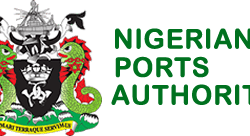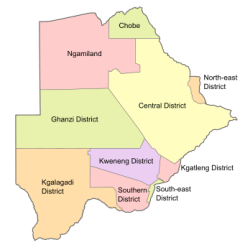Ipokia Local Government came into being along side other created Local Government on 13th December, 1996 and was carved out of the old YEWA SOUTH Local Government it shares boundaries withYewa North Local Government in the north, Lagos state in the south, Republic of Benin in the west, and both Yewa South and Ado-Odo/Ota Local Government in the east.
It is significant to note that this Local Government is blessed with a very rich island known as TONGEJI ISLAND.
This Local Government Area has 12 wards, Ipokia ward I, Ipokia ward II, Maun ward I, Maun ward II, Idiroko ward, Ajegunle, Ago Sasa, Tube, Ijofin, Agada, Ihunbo/Ilase, and Ifoyintedo. Its headquarters is in Ipokia.
PEOPLE
The inhabitants of this Local Government area are predominantly Anagos, Eyos and Eguns.
POPULATION
The projected population of this Local Government Area is about 300,000 (1991 census figures).
OCCUPATION
The people are predominantly Farmers.
EDUCATION
The Local Government has 72 public primary schools & 10 secondary schools. There are also an appreciative number of private investments in the education industry, with about 27 private nursery & primary schools and 2 private secondary schools.
TRADITIONAL RULERS
The Local Government is blessed with many traditional rulers of various grades. They are:
Oba Raufu Adeole The Onipokia of Ipokia land
Oba John Olakunle Ojo The Oniko of Ikoland
Oba Samuel Adeosun The Alase of Ilase
Oba Jacob Fase The Onihunbo of Ihunbo
Oba James Oyebi Elegbede The Oja of Agosasa
Oba Gabriel Igbowu The Opo of Idosemo
Oba Moruf Awode The Ololo of Ijofin
Oba Obabiolorunkosi Okiki The Akoko of Tongeji Island
Ogun State
Ogun is a major industrial state in Nigeria. It is located in the country’s south western zone.
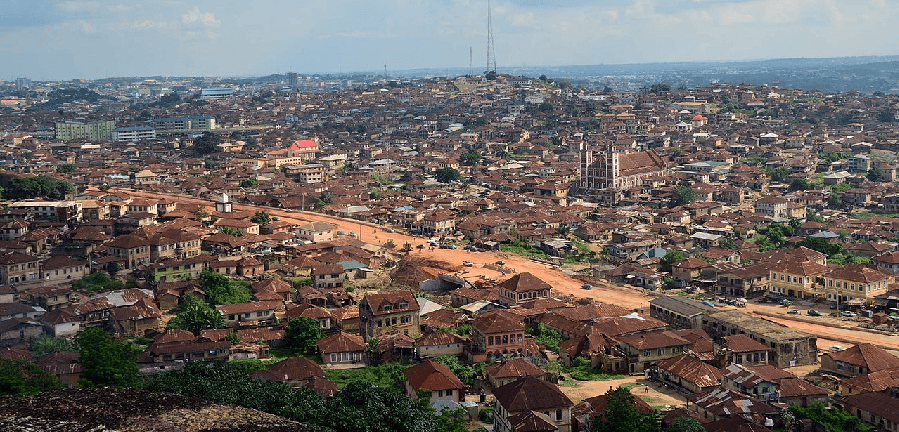
Nicknamed the “Gateway to Nigeria”, the state is notable for having a high concentration of industrial estates and being a major manufacturing hub in Nigeria.
Major factories in Ogun include the Dangote Cement factory in Ibese, Nestle, Lafarge Cement factory in Ewekoro, Memmcol in Orimerunmu, Coleman Cables in Sagamu and Arepo, Procter & Gamble in Agbara, amongst others.
Founded
It was created on 3 February 1976 from the former Western State.
Boundaries
Ogun State borders Lagos State to the south, Oyo State and Osun State to the north, Ondo State to the east, and the Republic of Benin to the west.
Capital
Abeokuta is both Ogun State’s capital and most populous city
Important cities
Important cities in the state include Abeokuta , Ijebu Ode, the royal capital of the Ijebu Kingdom, and Sagamu, Nigeria’s leading kola nut grower.


Geography
Ogun state is covered predominantly by rain forest and has wooden savanna in the northwest.
Land area
Ogun State has a Land Area of 16,409.26 square kilometers.
Major tribe
Ogun State is mostly Yoruba with the Yoruba language serving as the major one in the state.
Religion
The main religion in Ogun State is Christianity. A certain amount of other religions are being practiced.
Agriculture
Ogun State is noted for being the almost exclusive site of Ofada rice production.
TOURISM SITES
Olumo Rock in Abeokuta, Birikisu Sugbo Shrine at Oke-Eri, Yemoji Natural Swimming Pool at Ijebu-Ode, Oyan Dam in Abeokuta North, Iwopin Boat Regatta and Ebute-Oni in Ogun Waterside.
Other Sites are Madam Tinubu Shrine in Abeokuta, Oronna Shrine in Ilaro, Area J4 Forest Reserve; Tongeji Island in Ipokia, Old Manse at Ogbe, Abeokuta, St. James Anglican School, Ota and Ijamido River Shrine in Ota.
Check out our Tourism Gallery
LOCAL GOVERNMENT AREAS
- Abeokuta -North
- Abeokuta South
- Ado-Odo/Ota
- Ewekoro
- Ifo
- Ijebu East
- Ijebu North
- Ijebu North-East
- Ijebu-Ode
- Ikenne
- Imeko-Afon
- Ipokia
- Obafemi/ Owode
- Odeda
- Odogbolu
- Ogun Waterside
- Remo North
- Sagamu
- Yewa North
- Yewa South
THE PEOPLE
The People of Ogun State belong to the Yoruba Ethnic Group of South-West Nigeria and also live in parts of Benin Republic and Togo, with substantial Diaspora elements in Brazil, Cuba and Sierra Leone, consequential to the Trans-Atlantic Slave Trade.
The Sub-groups are mainly the Egba, Yewa, Awori, Egun, Ijebu, Remo, Ikale and Ilaje, Anago, Ketu, Ohori etc.
PROMINENT PERSONS
Ogun is also home to many icons in Nigeria in particular and Africa in general.
Ogun sons and daughters make their mark in diverse professions and have contributed in no small measure to the development of the state and Nigeria both at home and abroad.
Ogun State has produced icons and pioneers such as:
• Alexander Akintola Sapara-Williams
The first Nigerian Lawyer
• Hon. Justice Olumuyiwa Jibowu
The first Nigerian Judge to sit on the Supreme Court Bench
• Sir Adetokunbo Ademola
The first Indigenous Chief Justice of Nigeria
• Chief Simeon Adebo
Pioneer Permanent Secretary, Head of Civil Service and Permanent Representative of Nigeria at the United Nations
• Chief Obafemi Awolowo
The first Nigerian Lawyer to head a Regional Government
• Professor Wole Soyinka
Black Africa’s first Nobel Laureate
• Adeoye Lambo
One-time Deputy Director General of the World Health Organisation
• Prof. Anthony Asiwaju
Renowned Historian
• Chief J. F. Odunjo
Foremost Author
• Oluṣẹgun Arẹmu Ọbasanjọ
A former Nigerian Army general and former President of Nigeria
LANGUAGES
Yoruba and English (Official Language) and several dialects of the sub-groups.
FESTIVALS
Agemo, Lisabi, Ogun, Igunnuko, Orisa-Oko, Egungun, Obirin-Ojowu, Gelede, Oro, Ojude-Oba and Sango.
POPULATION
The population of Ogun State based on 2006 Census was 3,751,140 comprising of 1,864,907 Males and 1,886,233 Females.
However, the projected population as at 2011 Census is 4,397,604 with 2,186,301 Males and 2,211,303 Females
The State is endowed with a favourable climate and good vegetation for all year round cultivation of various cash and food crops as well as livestock rearing.
VEGETATION
The climate is also conducive for business and industrial growth. In Ogun State, we have in the south, the evergreen forest vegetation and soil most suitable for the cultivation of cash and food crops like oil palm, rice, kola- nut, cocoa, cotton, cassava, cocoyam and vegetables. While in the north, we have a vast grazing savannah land that is suitable for animal husbandry. In addition to this, there are forest reserves, rivers and lagoons with a beautiful ocean front down south that is good for beach resorts.
NATURAL RESOURCES
The State has natural resources that include forest and water bodies as well as large quantities of mineral deposits, such as limestone, phosphate, granite stone, gypsum, bauxite, bitumen, feldspar, clay, glass sand, kaolin, quartz, tar sand and gemstones.
